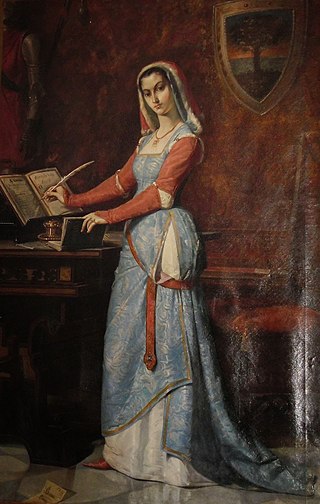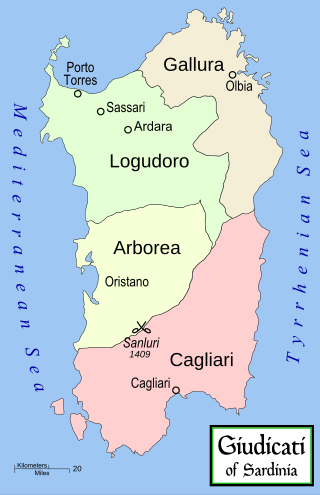
Eleanor of Arborea or Eleanor De Serra Bas was one of the most powerful and important, and one of the last, judges of the Judicate of Arborea in Sardinia, and Sardinia's most famous heroine. She is also known for updating of the Carta de Logu, promulgated by her father Marianus IV and revisited by her brother Hugh III.

The Judicate of Arborea or the Kingdom of Arborea was one of the four independent judicates into which the island of Sardinia was divided in the Middle Ages. It occupied the central-west portion of the island, wedged between Logudoro to the north and east, Cagliari to the south and east, and the Mediterranean Sea to the west. To the northeast of Logudoro was Gallura, with which Arborea had far less interaction. Arborea outlasted her neighbours, surviving well into the 15th century. At its greatest territorial extent it occupied the entire island except the cities of Alghero and Cagliari. The earliest known judicial seat was Tharros, though Oristano served as capital for most of its existence.

William I, royal name Salusio IV, was the judike of Cagliari, meaning "King", from 1188 to his death. His descendants and those of his immediate competitors intermarried to form the backbone of the Italian Aristocracy, and ultimately their descendants in the Medici clan are precursors to, and definers of later royalty and claims thereto.

The Kings or Judges of the Arborea were the local rulers of the west of Sardinia during the Middle Ages. Theirs was the longest-lasting judgedom, surviving as an independent state until the fifteenth century.

The kings or judges of Cagliari were the local rulers of the south of Sardinia during the Middle Ages. Theirs was the largest kingdom and for the eleventh through twelfth centuries contested the supremacy on the island with that of Logudoro. It was often an ally of the Republic of Pisa and an early supporter of Western monasticism.
Peter II was the Judge of Arborea from 1221 to his death. He was also Peter IV, Viscount of Bas. He was "pious and submissive to the church" and his extensive "donations of privileges and judicial lands impoverished his state of glory."
Hugh II was Judge of Arborea, reigning from 1321 until his death in 1336. He was the illegitimate son of Marianus III of Arborea and Paulesa de Serra.

Ubaldo II Visconti, son of Lamberto di Eldizio and Elena de Lacon, was the Judge of Gallura from 1225 to his death in 1238. He ruled every giudicato on the island of Sardinia at one point or another save Arborea.
Adelasia (1207–1259), was the Judge of Logudoro from 1236 and the titular Judge of Gallura from 1238.
Benedetta was the daughter and heiress of William I of Cagliari and Adelasia, daughter of Moroello Malaspina. She succeeded her father in January or February 1214.

Marianus II was the Judge of Logudoro from 1218 until his death. He was an ally of the Republic of Genoa and enemy of Pisa.

Peter I, of the Serra family, was the eldest son and successor of Barisone II of Arborea, reigning from 1186 to his death. His mother was Barisone's first wife, Pellegrina de Lacon. He was crowned King of Sardinia, the title his father had used, with the support of a majority of the Arborean nobility.
William of Capraia was the regent for Marianus II of Arborea from 1241 until his death, being entitled "Judge" from 1250 on.

Marianus II was the Judge of Arborea from 1241 to his death. With skilled military action, he came to control more than half of the island of Sardinia. By his control of the vast central plains and the rich deposits of precious metals, he increased the riches of his Judicate and staved off the general economic decline affecting the rest of Europe at the time.
Anselm of Capraia was a Pisan count. His political activity extended from the Republic of Pisa to Sardinia.
Marianus V was the Judge of Arborea from 1387 until his death. His surname was Doria, but since he belonged to the ruling house of Arborea he is often dynastically called Bas-Serra, or Doria-Bas. Younger brother and successor of Frederick, he was a minor upon his succession and was under the tutelage of his mother Eleanor.
Orzocorre I was the Judge of Arborea from circa 1070 to circa 1100 and is the first ruler of Arborea about whom anything substantial is known. He was the founder of an Arborean dynasty which reigned until 1185. He succeeded Marianus I, about whose government nothing is known, though some presume that Orzocorre was his son. If true, this would make Orzocorre a member of the Thori family.

Brancaleone Doria was the husband of Eleanor of Arborea, regent of the Giudicato of Arborea on the island of Sardinia in the late 14th century. He was a scion of the influential Doria family of the Republic of Genoa, the son of the elder Brancaleone and a woman named Giacomina. On 16 March 1357, he became a vassal of Peter IV of Aragon, the nominal King of Sardinia, to legitimate the possessions of his father on the island.
Marianus is a male name, formerly an ancient Roman family name, derived from Marius. Marianus may refer to:

The Sardinian–Aragonese war was a late medieval conflict lasting from 1353 to 1420. The fight was over supremacy of the land and took place between the Judicate of Arborea -- allied with the Sardinian branch of the Doria family and Genoa -- and the Kingdom of Sardinia, the latter of which had been part of the Crown of Aragon since 1324.







